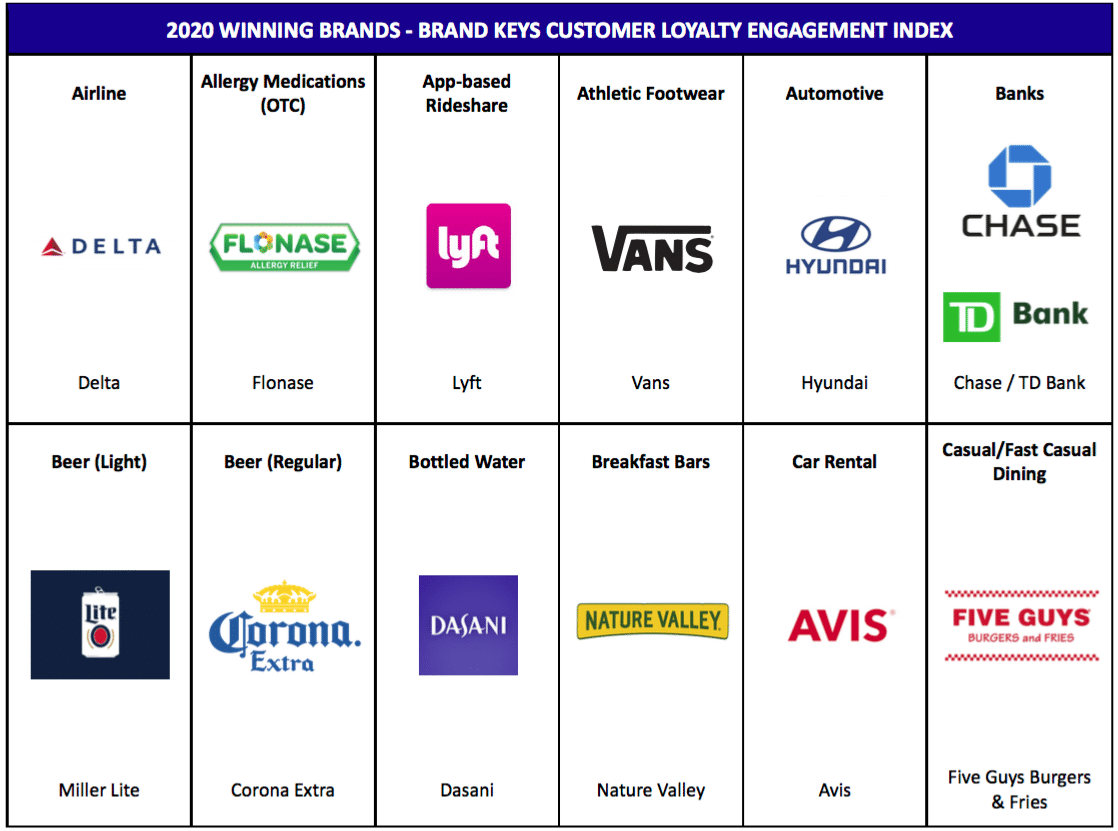Today’s lightning-speed marketplace has made shopping, browsing, comparing and reviewing products and brands easier than ever—and as a result, consumes have become more unreliable brand advocates. In fact, traditional brand loyalty has been thought to be on the edge of extinction in the modern environment—but new research from engagement and loyalty research firm Brand Keys explains how this might be oversimplifying what’s in reality a thriving but complicated brand-loyalty landscape.
According to the firm’s new Customer Loyalty Engagement Index (CLEI), customer brand loyalty has actually increased on average 20 percent from 2019 to 2020 across 85 leading B2C, B2B, and D2C categories, which encompass 16 industry sectors and 833 brands.
“Analysts, consulting firms, and research practices that declared brand loyalty dead are talking about a consumer loyalty model that expired in 1990,“ said Robert Passikoff, president of Brand Keys, in a news release. “Back then, loyalty wasa black-and-white issue for consumers. But loyalty didn’t die—rather, it has evolved in a more complex marketplace with more sophisticated viewers who expect much, much more.”
How complex? Ninety-three percent of the broadcast and entertainment path-to-purchase category loyalty drivers have new, consumer-generated configurations. Attribute, benefit, and value components that form the components of those drivers have were more static, but also more emotional, and appeared in only 25 percent of the sectors.
Broadcast & Entertainment Brands’ 2020 Loyalty Focus:
(Numbers in parentheses indicate YOY increases of in-market brand loyalty)
- Netflix (Streaming Video +23 percent)
- MSNBC (AM Cable News [Morning Joe] +21 percent)
- Samsung (Fat Screen TV+18 percent)
- MLB /NFL (Major League Sports +16 percent)
- FOX News (PM Cable News+16 percent)
- Google (Online Music +12 percent)
- Spotify (online Music +12 percent)
- Ticketmaster (Ticketing Services +11 percent)
- Grado (Headphones +6 percent)
- Good Morning America (Network AM News +5 percent)
- NBC (Network PM News +4 percent)
- Red Dead Redemption 2 (Major League Video +2 percent)
Defining Loyalty for the 21st Century
“Two decades into the 21st century the world has more complex brand and mediascapes. It’s more data-rich and technologically-intensive. Consumers are more complex, connected, and complicated. They connect with each other before even considering connecting to a brand and assess loyalty relative to how they envision an ‘Ideal’ brand,” said Passikoff.
“It only takes a nanosecond for consumers to note how well a brand is ‘seen’ to meet their expectations for the path-to-purchase drivers that defines behavior toward and fidelity to a brand. That’s the 21st century version of brand loyalty,” said Passikoff. “Brands that can meet consumer expectations will alwayssee higher levels of engagement, loyalty, and sales.”
Independent validations by the ARF verify that definition. Correlations between assessments based on this updated definition of loyalty and consumer behavior are 0.80+.
“Marketers who focus on so-called ‘loyalty programs’ expecting real brand allegiance, totally miss the point,” noted Passikoff.
Orders of Path-to-Purchase Loyalty Driver Change, Become More Complex
“Categories and brands are not static” noted Passikoff. “They change, and how consumers view, compare, and buy, are governed by the order and level of expectation of the key loyalty drivers in any category.”
Disruptive market forces, technology, innovation and relentless competition all play a part in how the order of loyalty drivers shift and why consumer-value components become more complex. “But the end results are predominantly driven by consumers’ attitudes and desires, much of which is unarticulated,” said Passikoff, “and virtually all of which are emotionally-based.”
“Brand Keys’ predictive research methodology identifies shifts 12 to 18 months beforethey appear in traditional brand tracking, focus groups or traditional research surveys based on a 20th century definition of ‘loyalty’.”
The order of importance of drivers represents a value continuum that consumers navigate, largely unconsciously, in their purchase and loyalty journeys. Consumers hold specific expectations for each category loyalty driver and use their expectations for the CategoryIdealas a “yardstick” against which they measure brand performance. Brands that best meet consumer expectations alwayshave the most-loyal customers and, not-so-coincidently, the strongest sales and highest profits.
For example, below is the order of the path-to-purchase loyalty drivers for the Morning News category in 2019. Thenumbers in parentheses below the drivers indicate the percent-contribution the individual driver makes to brand loyalty.
Changes of +5% are significant at the 95 percent confidence level.
For the Morning News Category in 2020, not only has the orderof the loyalty drivers changed (and how consumers assess these brands), but theattribute, benefit, and valuecomponentsthat make up the drivers have become more complex. These changes represent the genuine consumer perspective because the output of the model obviates the fact that consumers don’tthink how they feel, they don’t say what theythink, and don’t dowhat they say they will.
Loyalty is Harder for Brands in “Commoditized” Sectors
“The majority of 2020’s categories and brands will have to address these more complex paths-to-purchase loyalty drivers and more emotionally-based customer values,” said Passikoff. “But some categories have been inert, without changes to the order of loyalty drivers and no added consumer-value complexity. These brands start to look like commodities and competing in a commoditized sector makes for a much tougher battle for loyalty.”
Categories approaching commodity status included: gasoline, beer, cosmetics (mass), pet food, home improvement retail, bottled water, yogurt products, economy hotels, and packaged cold cuts.
Defining the Loyalty Challenge
“Marketers face a three-part challenge to leverage brand loyalty—as opposed to relying on legacy point programs,” said Passikoff.“ First, they need to recognize it is 2020, not 1985, and define ‘loyalty’ as it applies to today’s consumers and the emerging marketplace. Second, they need to define objectives based on how customers actually view their category and identify what consumers expect, not based on tweet-counts or NPS scores, but on actual loyalty assessments. Finally, marketers need to design tactics that provide emotional brand engagement, not just more devalued points.”
“Do all that, and you’ll have more engaged, more loyal customers which comes hand-in-hand with increased sales and profits. That’s what real loyalty is all about today. It’s also a pretty good definition of ‘successful marketing,’” Passikoff concluded.
For the 2020 CLEI survey, 62,474 consumers, 16 to 65 years of age from the nine US Census Regions, self-selected the categories in which they are consumers and the brands for which they are customers. This year, Brand Keys examined 85 categories and 833 brands. Forty percent were interviewed by phone, 40 percent via face-to-face interviews (to account for cell phone-only households), and 20 percent were interviewed online.






